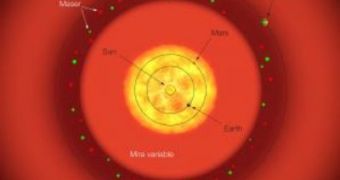An international team of astronomers has recently performed the most possibly detailed study of a giant pulsating red star and its environment, in an effort to improve our understanding of the processes of a star's death.
The analysis focused on three layers of the outer envelope of the red giant: the maser shell, the dust shell and the molecular shell and described the way evolved stars lose mass and return it to the interstellar medium, before they die.
Red giants are stars of 1000 times the volume of the Sun which have exhausted the supply of hydrogen in their cores and switched to fusing hydrogen in a shell outside the core. The Sun is expected to become a red giant in about five billion years. It is calculated that the Sun will become sufficiently large to engulf the current orbits of some of the solar system's inner planets, including Earth.
The subject of the study was S Orionis (S Ori), a Mira-type variable star, near its gloomy end as a white dwarf, looking exactly as the Sun in about 5 billion years. The red giant is in fact very large and loses huge amounts of matter, and it continuously ejects large quantities of matter into space, around the equivalent of Earth's mass every year.
"Because we are all stardust, studying the phases in the life of a star when processed matter is sent back to the interstellar medium to be used for the next generation of stars, planets... and humans, is very important," said Markus Wittkowski, lead author of the paper reporting the results.
This star pulsates at regular 420 days intervals and changes its brightness by a factor of the order of 500, while its diameter varies by about 20%.
"Astronomers are like medical doctors, who use various instruments to examine different parts of the human body," said co-author David Boboltz. "While the mouth can be checked with a simple light, a stethoscope is required to listen to the heart beat. Similarly the heart of the star can be observed in the optical, the molecular and dust layers can be studied in the infrared and the maser emission can be probed with radio instruments. Only the combination of the three gives us a more complete picture of the star and its envelope."
Using this technique, they found that the diameter of the star varies between 7.9 milliarcseconds and 9.7 milliarcseconds, which means that the difference between the minimum and the maximum diameter is 3.8 to 4.6 times the distance between the Earth and the Sun.
The analysis will continue and astronomers hope to find out even more about the complex internal processes of a dying red giant. "We know one chapter of the secret life of a Mira star, but much more can be learned in the near future, when we add near-infrared interferometry with the AMBER instrument on the VLTI to our (already broad) observational approach," said Wittkowski.

 14 DAY TRIAL //
14 DAY TRIAL //